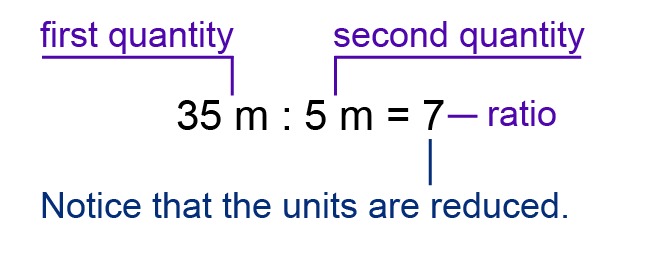16. Ratio
Ratio
Ratios are used to compare quantities that have the same unit. For example, the ratio of girls to boys in a sports club can be [[$ 4: 5 $]]. If the girls and boys were divided into the smallest possible groups, so that each group would only have either girls or boys, and there would be an equal number of groups, the girls would form groups of four and the boys would form groups of five. The ratio does not tell you how many girls, boys or members there are in the club. However, the following conclusions can be drawn from the ratio:
- The number of girls is divisible by four.
- The number of boys is divisible by five.
- The number of all members is divisible by nine.
The ratio of two quantities or numbers is a number that indicates how many times the latter is included in the former.
Example 1
A block of flats is [[$ 35 $]] m tall. In contrast, a detached house is [[$ 5 $]] m tall. Calculate the ratio between the heights of the two buildings.
| [[$ \dfrac{35 \text{ m}}{5 \text{ m}} = 7 $]] | The height of the block of flats is seven times the height of the detached house. |
| [[$ \dfrac{5 \text{ m}}{35 \text{ m}} = \dfrac{1}{7} $]] | The height of the detached house is one seventh of the height of the block of flats. |
In ratios, a colon ":" is often used as a sign of division.

When calculating a ratio, the two quantities that are compared should have the same unit. Because of this, the units are reduced when the ratio is calculated. Thus, the value of the ratio has no unit. If the parts of the ratio are not in the same unit, they must be converted into the same unit before the value is calculated.
NB! Ratios are usually expressed so that both of their parts are integers.
Exercises
Basic exercises
Applied exercises
Challenging exercises
2/09. Submission folder for answers
Sinulla ei ole tarvittavia oikeuksia lähettää mitään.